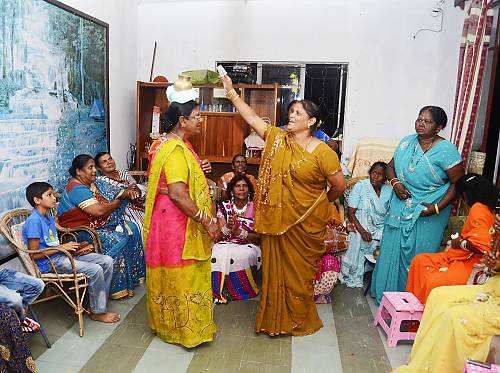
Geet Gawai, a Treasure of Intangible Heritage: Rivalry or Coexistence with Sangeet?
Long considered the heartbeat of Hindu weddings in Mauritius, the Geet Gawai, a sacred ritual of Bhojpuri origin, now finds itself sharing the stage — and often overshadowed — by a new star of modern celebrations: the Sangeet. With its choreographed dances and Instagram-ready aesthetics, the Sangeet has taken center stage in reception halls across the island. But does this mark a break from tradition — or a new form of harmony between the two worlds?
A Living Tradition, Now in Retreat
Before the spotlight and social media stories, Hindu weddings in Mauritius pulsed to the rhythm of the Geet Gawai, a ritual passed down orally from generation to generation. Held a few days before the wedding, the ceremony blends devotional songs, prayers, symbolic gestures, and improvised percussion. Around the dholak and clinking spoons on metal bowls, village women would sing verses learned from their mothers — in a joyful yet deeply sacred atmosphere.
“I still remember my grandmother, her hands stained yellow with turmeric, singing the old verses with the other women from the village. It was a sacred moment,” recalls Devika, 72, a geetharine from Dagotière.
For her, each song carried a blessing, each gesture a wish for the couple’s prosperity.
Until the 1970s, the ceremony remained strictly family-centered and female. Only later did geetharines venture onto public stages, open the ritual to men, and bring it to schools and television. Its inclusion on the UNESCO Intangible Cultural Heritage list in 2016 gave it international recognition — but not enough to halt its gradual decline in modern wedding practices.
The Sangeet: A Glamorous Import
Meanwhile, in the villas of Grand Baie and the reception halls of Moka, a new sound is taking over. Over the past decade, the Sangeet has become a fixture — a choreographed evening set to Bollywood hits (and sometimes Western pop), now one of the highlights of Mauritian weddings.
“We want something fun and modern, where everyone can take part — even our friends from abroad,” says Khushboo, 27, whose brother is getting married this week.
For her, the Sangeet is a bridge between cultures — a celebration that speaks the universal language of music and dance.
Behind this shift lies a powerful cultural influence: Bollywood. Romantic blockbusters have popularized the Sangeet as a must-have moment in any Indian-style wedding. Add social media pressure for beauty, spectacle, and shareable moments — and the Sangeet becomes a full-blown generational phenomenon.
It’s not just a party anymore; it’s a performance, crafted for the camera.
A Break — or an Evolution?
Not everyone is on board. Traditional voices see the Sangeet as a spectacle stripped of ritual meaning.
“The Sangeet is a show. The Geet Gawai is a soul,” says Bharati, a 68-year-old geetharine.
“Young people no longer know the real lyrics, they don’t understand their meaning. They want to dance, but they forget where we come from.”
Others, however, argue for adaptation rather than resistance.
“We have to move with the times. If we want our traditions to speak to the youth, we must adapt them. The Geet Gawai is beautiful, but it also needs renewal,” says Vikash, 32, a wedding planner.
Toward a Peaceful Coexistence?
Rather than choosing between tradition and modernity, some families opt for both — a Geet Gawai in an intimate family setting, followed by a lively Sangeet with friends and colleagues. A dual celebration where each generation finds its space and rhythm.
In Mauritius, a land of cultural fusion, the true challenge isn’t choosing sides, but finding balance. The goal is to restore the Geet Gawai’s dignity while embracing the Sangeet’s joyful modernity.
Dr. Sarita Boodhoo, a leading voice in Bhojpuri heritage preservation, sees no reason for conflict:
“The Sangeet has its place, of course. There is no threat. The two can coexist beautifully. There’s room for both,” she says.
“The Geet Gawai is carried by traditional singers who preserve ancient nuptial customs dating back to the Vedic era. The Sangeet is beautiful in its own way. But the Geet Gawai — that’s tradition,” she adds proudly.
Passing On Without Losing the Essence
Thankfully, many initiatives are emerging to keep the Geet Gawai alive — from Bhojpuri song workshops, TV and video capsules, and competitions by the MBC, to training programs at the Geet Gawai School of the Bhojpuri Speaking Union, and even its introduction into school curricula.
Some artists go even further — fusing traditional Geet Gawai melodies with electronic beats, creating modern remixes that appeal to younger audiences without betraying the soul of the tradition.
Because in the end, it’s not a question of rivalry — but of rhythm.
Tradition and modernity can sing in harmony, as long as both remember the same refrain: the celebration of love, community, and heritage.


